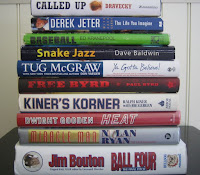"I think the story of 'Alice in Wonderland' in a way is a reminder that life is frightening, it can shift on you at any moment."
-Michael Sheen
(note - the links in this post will open in a new tab/window)
We all know the rule - "Never discuss politics, religion or the shift". Yes, it's quite a hot topic. I never assume, so if you don't know what the shift is you can read a short overview of it toward the end (second paragraph from the bottom) of one of my previous blog posts - http://sandlotwisdom.blogspot.com/2012/05/strategy-and-tactics-infield.html
The shift is bitterly debated between sportscasters, sports-writers, MLB bureaucrats, and fans. These debates are about 1. Does the shift work? and 2. Should it be outlawed?
 |
| Williams and Boudreau |
|
|
In a nutshell the infield shift (aka "the shfit") was created to derail the efforts of dead-pull hitters (a hitter who can only hit to his "power side" - e.g. left field for righty's). The infielders are moved to one side or another of the infield to blanket one side. One of the earliest uses of the shift was in the 1946 World Series by the Cardinals against Ted Williams of the Red Sox. The Cardinals picked up the idea from Lou Boudreau's Cleveland Indians who also used the shift against Williams.
The debates rage on. Is the shift useful and effective? How can we forget the 2009 World Series when Johnny Damon stole two bases against the Phillies when they pulled a shift? Let's look at the usefulness of the shift. I would like you to take a look at two web pages. They're not lengthy articles filled with charts and graphs. One contains a chart I want you to look at and the other some stats.
Take a look at this page - https://checkdownsports.net/2016/06/16/who-shifts/ . About 1/4 the way down (just below the photo of the shift) is a chart. Go ahead take a look. I'll wait right here ...
You came back! Glad you didn't abandon me (like that girl did in high school for the second-string kicker on the JV team - but I digress ...). After studying the chart you probably noticed a few things. 1. - The league as a whole shifts a lot! ... 2. - Some individual teams shift a lot!! Seems like every chance they get ... 3. - Some teams use the shift more wisely than others ... and 4. - Some teams hate it!!
Now, let's take a look at this page from the wonderful fangraphs site -
http://www.fangraphs.com/leaders.aspx?pos=all&stats=bat&lg=all&qual=y&type=0&season=2016&month=63&season1=2016&ind=0&team=0&rost=0&age=0&filter=&players=0&sort=5,d
There's a lot going on here, but it's just basically a page with stats on it. Notice the "Split" option (Fig. 1 below). It's set to "Shift - Traditional". In essence that means stats against the shift.
 |
| Fig. 1 |
If you scroll down a bit you'll see the below in Fig. 2. It's sorted by Plate Appearance (PA) to show which players are shifted against the most. Notice David Ortiz does very well against the shift (.340 BA).
 |
| Fig. 2 |
With all the facts presented above we seem to be swimming in an sea of subjectivity. Draw your own conclusions and feel free to leave comments on what you think.
You may (or may not - that's OK) have noticed that most shifts are against left handed batters. Recently there has been a trend where teams are shifting against righties and it's working! Why, you may ask haven't teams used the shift against the righty? The answer contains three reasons - one of which is antiquated thus rendered invalid. Remember, to shift against a right-handed batter you need to stack the left side of the infield toward third base. The 3rd baseman will play very close to the line, the shortstop and 2nd baseman close by. The first baseman will play in between first and second base. With a runner on first this configuration is almost impossible to pull-off defensively. The first baseman needs to hold the runner thus leaving a gaping hole on the right side of the infield (reason one!). Typically second basemen aren't that adept at going to their left (if they were they'd be a shortstop). The shift against a righty may require a second baseman to make a play to his left (reason two!). Years ago a shortstop had problems throwing from "the hole" - moving to his right to make a play. That was a concern for shifting against righties - having to make a longer throw since they are playing further away from first base. These days this really isn't a worry since shortstops can make that throw unbalanced (reason three debunked!).
Lastly, let's all turn and face the 800 lb. elephant in the room shall we? If defenses are moving players to one side of the infield (very unorthodox) then why can't hitters learn to hit to the opposite side (a hitting skill since the 1800's)? This is no conundrum - it's the almighty dollar. Power makes money and to hit with power you should pull the ball. Simple.
I hope you enjoy learning about baseball strategy. It's what makes baseball interesting.
Thanks for reading
-Tom
 The explanations are actually fairly simple for this common baseball precept. We're going to reference the "Run Expectancy Matrix" below. The table represents the average number of runs that scored, for a specific base/out situation. Take a look at it for a sec and get familiar with it.
The explanations are actually fairly simple for this common baseball precept. We're going to reference the "Run Expectancy Matrix" below. The table represents the average number of runs that scored, for a specific base/out situation. Take a look at it for a sec and get familiar with it. 












